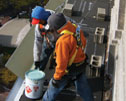The North American roofing industry is witnessing increasing popularity of numerous technologies aligned with the sustainability movement. Among these, roof coatings are receiving significant publicity from different groups capable of influencing consumer sentiment, including government policymakers, conservationists and coatings manufacturers.
For example, sustainability advocates identify reflective roof coatings' use as a cost-effective way to reduce building energy consumption in hot climates and control the heat island effect.
Roofing professionals long have recognized the viability and advantages of roof coatings for surfacing bituminous weatherproof roof membranes used as part of low-slope roof systems and possess a great deal of experience with coating applications over roof membranes. This is not the case with field coating steep-slope roof coverings. The fact is the most widely used steep-slope roof covering—asphalt shingles—is not designed to accept or require field-applied surfacings.
Coating products and paints advertised as suitable for application to asphalt shingle roof systems currently are available and marketed primarily to do-it-yourself homeowners. Promotional materials for most of the products position field coating as a cost-effective way to extend asphalt shingle roof system life. Language suggesting leak repair and energy-cost savings resulting from the use of reflective coatings also commonly is used.
Homeowners may consider field coating asphalt shingle roof systems more appealing than reroofing and seek information from roofing professionals. The following information is intended to assist roofing professionals who may be in a position to answer consumer questions related to field application of coatings over asphalt shingle roof systems.
Advertised benefits
Marketers of coatings for application over asphalt shingles claim their products offer a range of benefits though specific claims vary depending on the product. To learn about products' advertised benefits and evidence used to validate those benefits, I collected information from 10 Web sites promoting coating products for application over asphalt shingles.
The most common claim states field-applied coatings extend asphalt shingles' service lives. Other advertised advantages differ depending on product and range from simply "improves a roof's appearance" or "ultraviolet-resistant" to more specific claims, such as "rejuvenates shingles" or "fixes granules in place," to more radical claims, such as "repairs leaks," "forms a waterproofing membrane" or "reduces energy costs."
Arguments used to support the marketing claims are based on before and after photographs of roof systems, consumer testimonials and additional reassuring language published on coating suppliers' Web sites. Searches for test or laboratory evaluations of natural or accelerated weathering studies turned up no independently prepared test or laboratory reports that could validate many of the claims made in the online marketing materials.
Coating composition
A majority of coatings advertised for use on asphalt shingle roof systems share a common binder system. Information I collected from supplier Web sites indicates most of the coatings use a water-dispersed acrylic polymer binder commonly called latex or acrylic emulsion.
Many acrylic binder systems have proven performance in low-slope roof coating applications. Various acrylic binders are used in a range of successful elastomeric roof coatings, which display various degrees of elasticity, hardness, durability and permeability. Regrettably, physical property information is not consistently provided for the acrylic coatings I investigated. Notably, the promotional language in almost all cases claims products are vapor-permeable.
Acrylic-based products are available in a range of colors. Many suppliers promise their coatings perform as weather- and mold-resistant protective layers. White coatings typically are advertised as reflective. In some cases, it is implied coatings help realize energy savings by reducing the amount of heat absorbed by roof surfaces.
A few acrylic-based products are said to add thermal insulating value to roof surfaces. Marketing materials for these products claim their formulas contain technologically advanced components described as "ceramic microspheres" or "nanotechnology materials" characterized by extremely low thermal conductivities.
Some suppliers offer primers marketed for asphalt shingle surfaces for use with acrylic water-based coatings. These primers are composed primarily of petroleum distillates or contain acrylic resins and hydrocarbon solvents.
I found few examples of nonacrylic-based coatings marketed for application over asphalt shingles. Those I did find contain SEBS or similar thermoplastic rubber binders and hydrocarbon solvents.
Cured coatings are characterized as sealants for joints between dissimilar materials or as waterproofing membranes for surfaces depending on application type. They are said to be clear in color, have rubber-like flexibility and accept paint finish. Products using this formulation appear to function as effective vapor retarders when applied as continuous film according to application instructions.
Application
Because coatings for field application over asphalt shingles are marketed primarily to homeowners, ease of use is emphasized. Application instructions are designed for the average home-improvement enthusiast. Application by paint roller and brush commonly is recommended. Some products, typically primers, are intended for application with airless spray equipment.
Typical application instructions require shingles to be clean and dry before application begins though language for thermoplastic rubber-based coatings claims surface dampness will not interfere with adhesion. Dirt, debris and biological growth are to be removed. One of two options for cleaning typically is recommended: washing with water and detergent and then rinsing or pressure washing. A diluted bleach solution or proprietary cleaning agent may be recommended for eliminating algae, lichens and mildew.
NRCA and the Asphalt Roofing Manufacturers Association (ARMA) do not recommend pressure washing asphalt shingle roof systems because doing so may damage shingles.
Weather conditions appropriate for coating application typically are described as temperatures greater than 50 F and no precipitation for a period necessary to achieve moisture-resistant cure levels. Recommendations for coatings using hydrocarbon solvents generally are less restrictive. The initial cure time varies depending on product and/or number of coats and ranges from 12 to 72 hours. The upper temperature limit for application also varies depending on product or may not be provided. One supplier recommends application temperatures no higher than 95 F.
Asphalt shingles typically are subject to service conditions that make it impractical to fully abide by some of the recommendations described. The language used in the application instructions is consistent with the fact that water-borne acrylic coatings typically are sensitive to moisture and temperature until they cure.
Evaluation tools
ASTM D6083, "Standard Specification for Liquid Applied Acrylic Coating Used in Roofing," is the standard material specification for water-dispersed acrylic coatings used as field-applied surfacing in roofing applications. No ASTM International standard material specifications are available for sealants or field-applied roof coatings using thermoplastic rubber binders.
Two standard test methods for measuring roof coatings' solar reflectance are available. ASTM C1549, "Standard Test Method for Determination of Solar Reflectance Near Ambient Temperature Using a Portable Solar Reflectometer," provides a procedure for using a portable measuring device with an integral light source suitable for laboratory and field readings from small-area samples. ASTM E1918, "Standard Test Method for Measuring Solar Reflectance of Horizontal and Low-Sloped Surfaces in the Field," is intended for use on low-slope roof surfaces, samples a large area for measurement, can be used for readings from roughly textured surfaces and requires clear midday weather to perform measurements.
Roof coatings' thermal emittance may be measured according to ASTM E408, "Standard Test Methods for Total Normal Emittance of Surfaces Using Inspection-Meter Techniques," or ASTM C1371, "Standard Test Method for Determination of Emittance of Materials Near Room Temperature Using Portable Emissometers."
Thermal insulating properties are not associated with roof coatings; therefore, no standard test methods for evaluating thermal insulating performance of coatings in roofing applications are available. Consequently, it may not be practical to validate statements made about thermal insulating performance of field-applied roof coatings.
It may be difficult or impractical to objectively evaluate the physical properties and performance characteristics of coatings marketed for application over asphalt shingles. Compliance with ASTM D6083 was not indicated for any of the investigated products. Documentation for some of the products references standard test methods and standard material specifications; however, they are not standards used in roofing applications. Overall, the level of technical information presented is below par compared with that available for established low-slope roof system coatings.
Physical property information typically available includes density, solids content, volatile organic compound content, wet and dry film thickness, coverage rate, application temperature range and cure time. Some suppliers publish test values for additional cured film properties; however, test method designations are not always provided.
Concerns abound
The roofing industry is aware of a number of issues that could have negative consequences for field application of coatings over asphalt shingle roof systems. Anyone considering this type of application should be aware of the concerns so they can weigh them against the benefits claimed in coating product promotional materials.
Manufacturer recommendations
There are two sources available to those interested in learning asphalt shingle manufacturers' recommendations.
ARMA Technical Bulletin No. 227, "Field Coating of Installed Asphalt Shingles," strongly advises caution when considering field applying any coating over installed asphalt shingles. The bulletin discusses problems reported after field coating asphalt shingles and advises homeowners to contact shingle manufacturers for approval before field coating asphalt shingles. To access the bulletin, visit ARMA's Web site at www.asphaltroofing.org, click on All About Roofing, scroll to Publications and click on Technical Bulletins.
GAF-Elk Contractor Services published Steep Slope Technical Point No. 151-09, "Field Coating of Installed GAF-Elk Asphalt Roofing Shingles," which does not recommend field application of coatings over asphalt shingles. The document addresses several questions likely to be asked by roofing consumers interested in field coating asphalt shingles. It is available from GAF-Elk's Web site at www.gaf.com/Document-Library/DocList.aspx.
The ARMA and GAF-Elk documents caution that the claims made about benefits of field coating asphalt shingles have not been well-documented or evaluated.
Other asphalt shingle manufacturers either take ARMA's position, do not publish recommendations addressing field coating or take the position that field coating has negligible effects on asphalt shingles provided water-based latex paints are used. Hydrocarbon solvent-based coatings are not recommended for use on asphalt shingles because the solvent may soften the asphalt coating.
Warranties
Language in two manufacturers' shingle warranties specifically excludes coverage for damage to their products caused by coating or painting. It is reasonable to expect other manufacturers that do not include field coating-specific language in their product warranties would claim the exclusion applies to their products based on their warranties' more generally defined exclusions.
Drainage and permeance
Field coating asphalt shingles is at odds with one of the fundamental working principles of shingled roofing.
Shingled roof coverings shed water. In other words, shingles rely on gravity to do most of the work of keeping out water. Sometimes, water travels underneath shingles via capillary action, wind force or when large volumes drain down valleys. When this occurs, shingles allow water to run down and to the outside surface of a roof.
When a coating is applied over roof coverings installed shingle-fashion, especially when it is intended to seal shingles at edges or form a continuous membrane, drainage paths for water trapped under the roof's outer surface may be cut off. Although wind-driven rain or water entry because of capillary action may be controlled or eliminated, the most common water entry locations where dissimilar materials meet at flashing elements can remain problematic. The potential for damage to underlayment and deck sheathing, as well as leaks from water infiltrating at flashing locations, is increased.
Additionally, depending on the coating type, field application over asphalt shingles may lower an asphalt shingle roof system's vapor permeability.
Asphalt shingle roof systems are vapor-permeable because joints between individual shingles allow vapor to pass through. Some coating formulations are effective vapor retarders. Applying a vapor-retardant coating to an asphalt shingle roof system's surface likely will compromise a roof assembly's self-drying characteristics.
Some roof assemblies may accommodate this with existing or additional ventilation. For other roof assemblies, the change in moisture transport resulting from coatings may be too much to maintain a noncondensing environment in attic or ventilation spaces.
Code restrictions
Local building codes may prohibit field applying coatings over asphalt shingle roof systems.
For example, 2007 Florida Building Code: Residential, Chapter 44—High-Velocity Hurricane Zones contains the following language applicable to reroofing residential buildings no more than three stories in height in Broward and Miami-Dade counties: "R4402.10.18.1 No sprayed polyurethane foam (PUF) and/or elastomeric coating systems shall be applied over existing composition shingles."
Also, 2007 Florida Building Code: Building, Chapter 15—Roof Assemblies and Rooftop Structures contains the following similar language: "1521.18.1 No PUF and/or elastomeric coating systems shall be applied over existing composition shingles."
Fire-resistance ratings
A field-coated asphalt shingle roof system likely does not have an external fire-resistance rating. A coating is given a fire-resistance rating as a component of a specific roof assembly based on testing at a specific roof slope. Coatings marketed for application on asphalt shingle roof systems often do not possess fire-resistance ratings.
Roof coatings rated for fire resistance as part of low-slope bituminous roof systems are not suitable for application over asphalt shingle roof systems. Fire-resistance ratings for roof coatings and roof coating systems designed for application directly over bituminous membrane roof systems are limited to roof slopes less than the 2-in-12 (9-degree) minimum prescribed by building codes for asphalt shingle system applications. Additionally, some coatings manufacturers state their products are not appropriate for application over asphalt shingles.
Summing it up
No evidence currently is available to correlate marketing claims with actual performance of field-applied coatings over asphalt shingle roof systems, and such an application subjects a roof system and its owner to specific risks the owner should understand before making a decision to field coat an asphalt shingle roof system. A thorough cost-benefit analysis may prove that known concerns within the roofing industry outweigh the potential benefits.
Maciek Rupar is an NRCA director of technical services.



